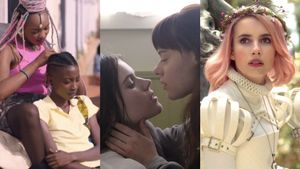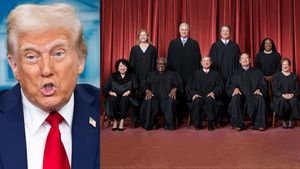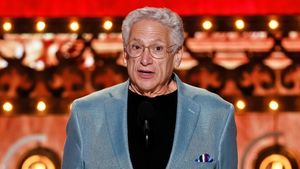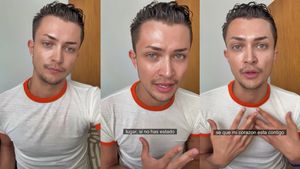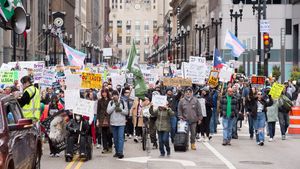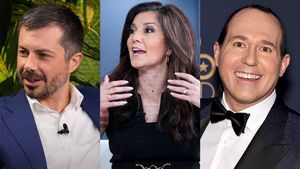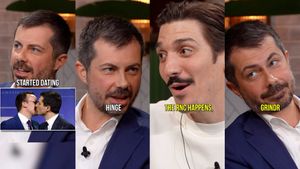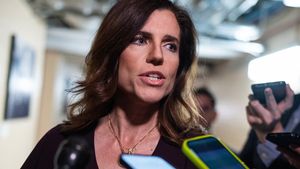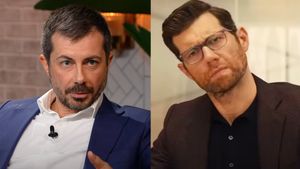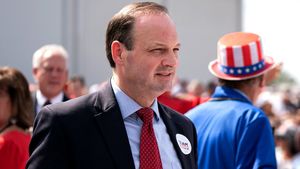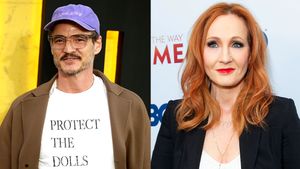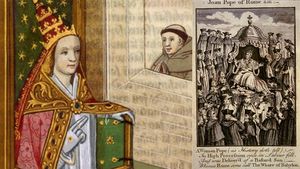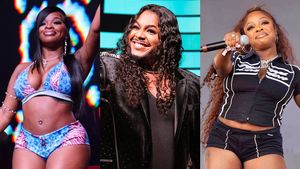Star Trekhas always been a franchise known for it’s progressiveness, especially when it comes to representation of minorities and a willingness to tackle modern social issues. This was perhaps doubly true of the franchise’s oft overlooked, yet highly-praised, darker entry Star Trek: Deep Space Nine. Over the course of it’s seven season run from 1993 to 1999, DS9 managed to tackle complicated issues of race, terrorism, genocide, homelessness, religious tolerance, and numerous difficult topics in a franchise that typically only had time to glance at a subject before "boldly" moving on. But despite DS9’s high pedigree, the people behind the show still feel like they failed in one particular aspect: accurately representing the LGBTQ community.
[iframe https://giphy.com/embed/i6jkJknw5YSVG allowfullscreen="" class=^{{"giphy-embed"}}^ frameborder="0" height="364" width="480"]
In the recently released documentary What We Left Behind, Deep Space Nine’s showrunner Ira Steven Behr admitted the show failed to go all-in when it came to sexuality and gender. In the film, when discussing the episode "Rejoined," the series' only episode to focus on a same-sex relationship, Behr stated: "We did not earn [credit for discussing] sexual identity… One episode in seven years, we could have done better. Trust me. We should have done better." Behr also discussed a missed opportunity to feature a recurring gay character with the morally ambiguous fan-favorite Cardassian Garak.
"Garak was clearly gay. I mean, everyone knew it and we never played it. What we should have done after the "The Wire" in season 2, the episode where Bashier helps Garak’s addiction, was we should have had Garak come on to Bashier as a gay Cardassian." When asked if the studio would have allowed that potential character choice, Behr answered honestly with, "Probably not, but we never asked."
Andy Robinson, who portrayed Garak, also stated that he knew right from the start his character was gay. In an interview with IGN about the documentary, when asked if he chose to play Garak as having a romantic interest in series regular Dr. Julian Bashier, Robinson said:
"Yeah, at the beginning. Because I was trying to think, 'Okay, why does Garak then pick this guy to make a relationship with?' And it was purely an actor’s choice in that very first scene in that first episode I was in. That essentially to give myself that actor Andy something to play, I decided that Garak was sexuality attracted to Dr. Bashier...I’m trying to sort of break conventions. It doesn’t become a 'gay thing,' or anything like that. It simply becomes an attraction. And so when I see this young man whose obviously a very good-looking young man and intelligent, and I think it’s his intelligence as much as his looks that are attractive, I played that. [laughs] That created a stir that I loved actually."
Robinson also later wrote the best-selling Star Trek book A Stitch in Time, which gave more direct nods to Garak’s sexuality.
[iframe https://giphy.com/embed/wAjNjOM2slTGw allowfullscreen="" class=^{{"giphy-embed"}}^ frameborder="0" height="360" width="480"]
Despite it’s progressive roots, Star Trek as a whole has had a complicated relationship with LGBTQ issues. An episode entitled "Blood and Fire" written by David Gerrold for The Next Generation that was to focus on the HIV epidemic never made it to production. Despite publicly stating several times that he would include gay characters in the series, creator Gene Roddenberry died without ever fulfilling that promise. Several franchise writers and actors like Ronald D. Moore and Kate Mulgrew would argue for and later criticized the franchise for failing to address the LGBTQ community. Some accused franchise executive producer Rick Berman of preventing LGBTQ characters from being portrayed, though this has never been officially confirmed. While single episodes of The Next Generation and Enterprise would touch upon transgender and sexuality issues through alien metaphor, the franchise wouldn’t feature it’s first gay regular characters until Anthony Rapp and Wilson Cruz joined Star Trek Discovery in 2017, followed by Tig Notaro’s lesbian character Jet Reno earlier this year.
![]()
![]()
Ironically, before Discovery came along, Deep Space Nine had the most explicit (if occasionally problematic) representations of the LGBTQ community. In the series' mirror universe episodes, several "evil" versions of the main cast were bisexual, leaning into the depraved bisexual stereotype or the misconception that bisexuality and loose morals go hand-in-hand. The episode "Profit and Lace" also featured the character Quark getting a sex change with a story that played into the highly-damaging idea that trans women only wish to trick men into having sex with them, culminating in a "comedic" scene of sexual assault. The episode is widely considered to be one of the worst of the series and the franchise as a whole.
Yet, not every attempt by Deep Space Nine to address sexuality and gender issues fell flat. Many transgender fans of the series (this author included!) often point to Jadzia Dax as a wonderful metaphor for a trans character. Dax is a joined trill, a race of symbiotes that share memories across different lives. Some characters knew the now female Jadzia during her previous life as the male Curzon. Yet, no one seems to take issue with her change in gender. There is even a scene which showcases a perfect way to handle accidentally dead-naming someone, with Jadzia casually correcting a Klingon friend for calling her Curzon, and the Klingon immediately adjusting himself without missing a beat.
Jadzia herself also eschews gender stereotypes, playing a woman who has no problem wearing a beautiful feminine dress and yet will pick up a Klingon blade to battle her opponents to the death or give a complicated scientific explanation for a problem. According to the documentary, Jadzia actress Terry Farrell would affectionately refer to the character as "Action Barbie." She also shared the screen with several nuanced female characters on the show, which included Kira Neyrs, a former terrorist/freedom fighter dealing with PTSD, and Kai Winn, one of the franchise's best fleshed out villians.
The series would also use Jadzia to subtly address sexuality issues, with Jadzia's female lover from her previous male life wishing to continue their relationship. This storyline would lead to the first female-only kiss in the franchise, which was played with depth and care rather than fetishizing the moment. Farrell called out the important moment in the series during the documentary, saying, "We did something controversial that still to this day people come up to me and say 'Thank you.' That was the first time I felt like I saw two people just love each other not because of what their sex was but just because they really just loved each other."
[iframe https://giphy.com/embed/U6cRNs3cDJlPa allowfullscreen="" class=^{{"giphy-embed"}}^ frameborder="0" height="480" width="473"]
In the end, hearing Behr admit to the failures of the series when it comes to LGBTQ issues acknowledges the long climb that the franchise, and TV in general, has had to get to where it is today in terms of queer representation. Yet, the admittance doesn’t discredit the monumental achievement that Deep Space Nine was. The best part of What We Left Behind is that while it celebrates the series, it doesn’t shy away from admitting the show was far from perfect.
Deep Space Nine represents both sides of the coin. While it would be hard to argue that the series did well by the LGBTQ community, it certainly remained ahead of the curb when compared to the standards of the era in which it was created. This by no means gives the series a pass for it’s more problematic elements, but as with everything on Deep Space Nine, the issue is more complicated than it initially appears.
Jessie Gender is the host of PRIDE's Nerd Out and is also a producer on the YouTube series Microsoft Unboxed. For more nerdy goodness rom Jessie, check out episodes of Nerd Out here!













































































